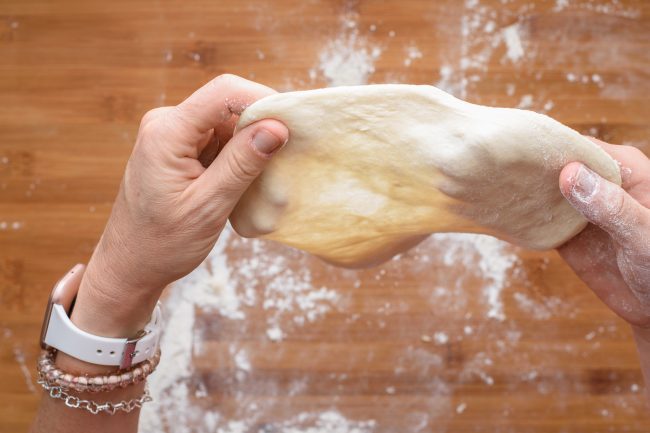Want to know what is gluten or just some tips for better dough? Check out all about gluten to make the best of all!

Gluten, a network of protein molecules, contributes to the elasticity and structure of various culinary staples like ramen noodles, pizza crusts, and bread. The creation of gluten involves a process where specific grain flours, when mixed with water, form this essential component.
- Bran
The protective outer layer - Germ or seed embryo
- Endosperm
The starch bit.
Moreover certain grains—such as wheat, barley, and rye—contain two proteins crucial for gluten formation:
- Glutenin
- Gliadin
Flours containing these proteins are termed “glutenous” or possessing “gluten potential.” Conversely, flours devoid of these proteins, like rice flour, corn flour, and buckwheat flour, are labeled as gluten-free. However, to replicate similar textures in gluten-free baked goods, stabilizing agents such as xanthan gum, guar gum, or eggs are required.
Ground nuts labeled as flour, such as coconut flour or almond flour are not part of this discussion.
How gluten forms
When water mixes with glutenous flour, two essential transformations occur:
- Glutenin connection
within the flour intertwining to create lengthy, coiled chains that form connections with each other.
During the process of mixing, kneading, and allowing sufficient resting time fosters the development of these connections within the dough, granting it the necessary attributes for stretching and rebounding A.K.A. elasticity. - Gliadin molecules
maintain their compact configuration enabling segments of the glutenins to move past each other without bonding. This behavior significantly contributes to the dough’s extensibility—its capacity to be molded and maintain its shape throughout cooking or baking.
Together, the collaborative action of glutenin and gliadin confers upon dough its viscoelastic attributes—the capacity to be stretched and shaped concurrently. Initially, these two proteins lack a structured interaction.
The process of untangling and aligning glutenin and gliadin is fundamental before successfully binding them into gluten to form any dough or batter. Liquid aids in the untangling, mixing merges the proteins, and kneading stitches them into a sheet.
Further mixing and kneading lead to the arrangement of protein molecules into a mesh-like structure often referred to as a gluten network or “sheet.”
A gluten network plays a pivotal role in various batters and doughs, from hand-pulled noodles to pancakes to baguettes. Mastering the control of gluten development remains crucial in creating tender muffins, springy and chewy noodles, crusty bread, and delicate pastries like pie dough that avoid toughness.

Controlling Gluten Formation
It’s important to note that not all gluten networks are identical, and an abundance of gluten isn’t necessarily superior to a lesser quantity.
- Increased gluten development yield foods with a livelier, more resilient texture.
- Reduced gluten development leads to softer or more delicate results.
Flour
The most critical decision in determining the quantity of gluten desired involves selecting the appropriate flour. Typically, flours with higher protein content—encompassing more glutenin and gliadin—yield more robust and intricate gluten structures.
- 9 – 15% Protein content
Whole wheat, durum, bread, and all-purpose flours making them suitable for heartier foods such as bread and pasta. - 7 – 9% Protein content
On the lower end are pastry and cake flours ideal for crafting delicate, tender baked goods.
Pentospans
Despite barley and rye being relatively high in protein, their gluten potential is limited due to the presence of molecules known as pentosans. Upon water integration, pentosans absorb and retain water, forming a sticky gel that impedes gluten development. Wheat also contains pentosans, but in smaller quantities that actually assist in gluten formation rather than obstructing it.
Similar protein levels among these flours don’t necessarily imply uniform reactions when crafted into dough. The presence or absence of the grain’s germ and bran can significantly influence gluten development. The coarse, fibrous bran particles found in whole wheat flours, for instance, cut through gluten strands as they form, leading to denser dough and bread.
Water
Water plays an equally crucial role as flour in the creation of doughs and batters since gluten formation is dependent on the addition of water or any water-based liquid to the flour. The quantity of water directly impacts the hydration of the flour, facilitating the untangling and alignment of the flour’s proteins—glutenin and gliadin—essential for subsequent gluten formation.
Water content significantly influences the initial texture of the dough.
- Drier doughs exhibit firmness and reduced extensibility.
- Wetter doughs tend to be softer and adhesive.
Hydration levels
A dough consisting of 1,000 grams of bread flour combined with 800g of water translates to 80% hydration.
- <- 60% Hydration level
Typical in bagel, noodle or fresh egg pasta, begin as rigid mixtures, yielding chewier food outcomes. - 60 – 70% Hydration level
Neapolitan-style pizza, pasta, and most bread types. - 70% -> Hydration level
Focaccia or ciabatta usually exceeding 70%. Diluted gluten network, resulting in a softer, moister bread featuring an airy crumb with large pockets.
Once a dough is formed, irrespective of the water quantity added, further actions such as mixing, kneading, or manipulation are essential to intertwine the now-developed gluten strands into a robust “sheet.”
Kneading

Mixing, kneading, or folding, contributes to the development or assistance in the interweaving of the gluten “sheet.” The more a dough or batter is mixed or kneaded, the more robust its gluten network becomes.
Achieving tender muffins, pancakes, or waffles necessitates a gentle touch during mixing. Conversely, for crusty baguettes or chewy pizza, a more vigorous approach is preferred.
- At the initial stage of combining flour and water, gluten begins to form, albeit in a disorganized manner.
- During the kneading process for bread or noodle doughs, the molecules of gluten are agitated, inducing a state of stress. However, within the dough, microscopic long particles of fully developed gluten align themselves in parallel lines, despite being imperceptible to the naked eye. Bakers refer to visible manifestations of these bonds as “gluten strands,” evidence of gluten development.
- Increased kneading leads to more developed and organized gluten, resulting in a stiffer and denser dough. (Employing an electric mixer or food processor accelerates gluten development compared to manual mixing.)
High-hydration bread and noodle doughs typically undergo extensive kneading to establish a robust gluten network, ensuring the desired texture and shape before and after cooking.
No-knead bread
. Despite being termed “no-knead,” microscopic kneading occurs within the mixture.
Combination of flour, water, salt, and yeast is allowed to sit for a duration of 12 to 24 hours at room temperature. As the yeast consumes carbs and generates carbon dioxide, bubbles form, effectively manipulating and agitating the protein molecules to form an organized gluten structure.
Windowpane test

To assess gluten development gently stretching a piece of dough out of the main mass using the fingers to achieve a thin, nearly translucent consistency. A well-developed dough attains such thinness due to the tightening and reorganization of gluten strands during shaping. The tension generated in the shaping process aids the dough in expanding uniformly, resulting in consistent loaves.
Overmixing
Prolonged, forceful kneading can weaken and damage the gluten network. An overworked bread dough is initially “stickier, almost sweaty,” transitioning into an incredibly stretchable texture as the crosslinking ability of glutenin and gliadin molecules diminishes. Consequently, the gluten and dough lose their intended structure, resulting in poor volume and a coarse crumb upon baking. Overmixing by hand is rarely an issue and even on robotic mixers we need to knead for hours to such issue to arise.
Temperature
Temperature primarily affects gluten development when biological fermentation, like yeast, is involved in a project.
- Lower temperatures
decelerate fermentation, allowing the formation of gluten strands to “catch-up.” - Higher temperatures
expedite the process, compelling the gluten network to work more rigorously and swiftly.
Overproofing
When the carbon dioxide exerts excessive pressure on the dough, it might rupture the air pockets, releasing the trapped gas and causing the dough to deflate. Such overproofed dough, incapable of expanding significantly during baking due to a weakened or fractured gluten structure.
For more on this: How to bake with yeast
High temperatures
Hot temperatures solidify gluten networks in all dough types. The meticulously developed structure—achieved through blending flour with water and kneading or allowing the dough to rest—becomes established once the dough undergoes boiling for noodles or baking for bread.
Noodle dough, for instance, solidifies following a sustained period of boiling at 212°F / 100°C. During the cooking process, noodles absorb water, expand, soften, and release some surface starch into the water. Gluten attributes the characteristic firmness to al dente pasta.
Starch gelatinization starts at 130–150°F / 55–65°C and the baking is done when the inner dough of a loaf reaches temperatures of 185°F / 85°C
- Carbon dioxide and water vapor enclosed in the network expand, and the flour’s starches continue to gelatinize by absorbing water and swelling until their cellular walls reach their limit.
- Upon reaching over 212°F / 100°C, the boiling point of water, the flour’s starches start dehydrating, leading to the creation of the crumb. The gluten network’s role in this process contributes to the diverse textures of bread, whether it manifests as abundant nooks and crannies or a denser, chewier, or softer and more supple structure.
For more on this: All About Baking Temperatures
Salt
Salt offers more than just flavor. It plays a role in fortifying gluten. Apparently incorporating salt at a ratio of 1.5 to 2% of the flour’s weight fosters their bonding.
Ascorbic acid (Vitamin C)
Incorporating ascorbic acid (few drops of lemon juice) strengthens the gluten structure within bread dough, allowing it to retain more fermentation gas, thus increasing its volume. This method proves cost-effective for generating larger loaves. Bread enriched with ascorbic acid exhibits a finer, densely packed crumb, resulting in an exceptionally soft texture. For more on this: Ascorbic Acid in Baking
Tenderizers

Numerous doughs and batters incorporate ingredients designed to inhibit or restrict gluten development, fostering soft or tender textures.
Sugar
In larger amounts functions as a tenderizer. It achieves this by bonding with water molecules before they can associate with glutenin and gliadin proteins, hindering proper hydration of the flour and initially delaying gluten development. This contributes to the tenderness and moisture retention in doughs, exemplified in brioche, even after undergoing kneading to establish some gluten structure.
Fats
- Butter, egg yolks, oil, or milk act as “tenderizers” in doughs like brioche, challah, and babka by restricting gluten development. Coating glutenin and gliadin proteins with fat impedes their bonding, resulting in shorter gluten chains. Once baked, these breads feature softer crusts and delicate crumbs.
- Due to the high fat content of flaky doughs like pie crusts and scones, gluten strands encounter difficulties in forming, thus restraining gluten development.
- Certain pasta and noodle doughs incorporate egg yolks or oil to preserve softness in shapes and strands despite extensive kneading.
While fat can contribute to dough tenderness, excessive inhibition of gluten development may occur, and kneading might or might not assist in establishing or sustaining an optimal gluten network.
Dough Conditioners
Considered versatile tools in the domain of large-scale commercial bakeries, dough conditioners serve multiple purposes. They are primarily utilized to fortify gluten networks, refine breadcrumb structure, and prolong the shelf life of various doughs and baked goods. However, these are not readily accessible to home cooks, and for most home cooking endeavors, they are not indispensable.
Typically, dough conditioners encompass a blend of emulsifiers (enhancing water absorption and fortifying gluten strength), salts, and acids (optimizing gluten development), maturing agents (strengthening or weakening gluten), enzymes (enhancing browning and delaying staling), and additional additives that aid fermentation.
Summary
- Gluten forms when Glutenin and Gliadin meets water.
- Kneading facilitates gluten formation.
- Baking is done when the inner temperatures reaches 185°F / 85°C.
- Salt and Vitamin C encourages gluten formation.
- Fats prevent gluten structures to bond.